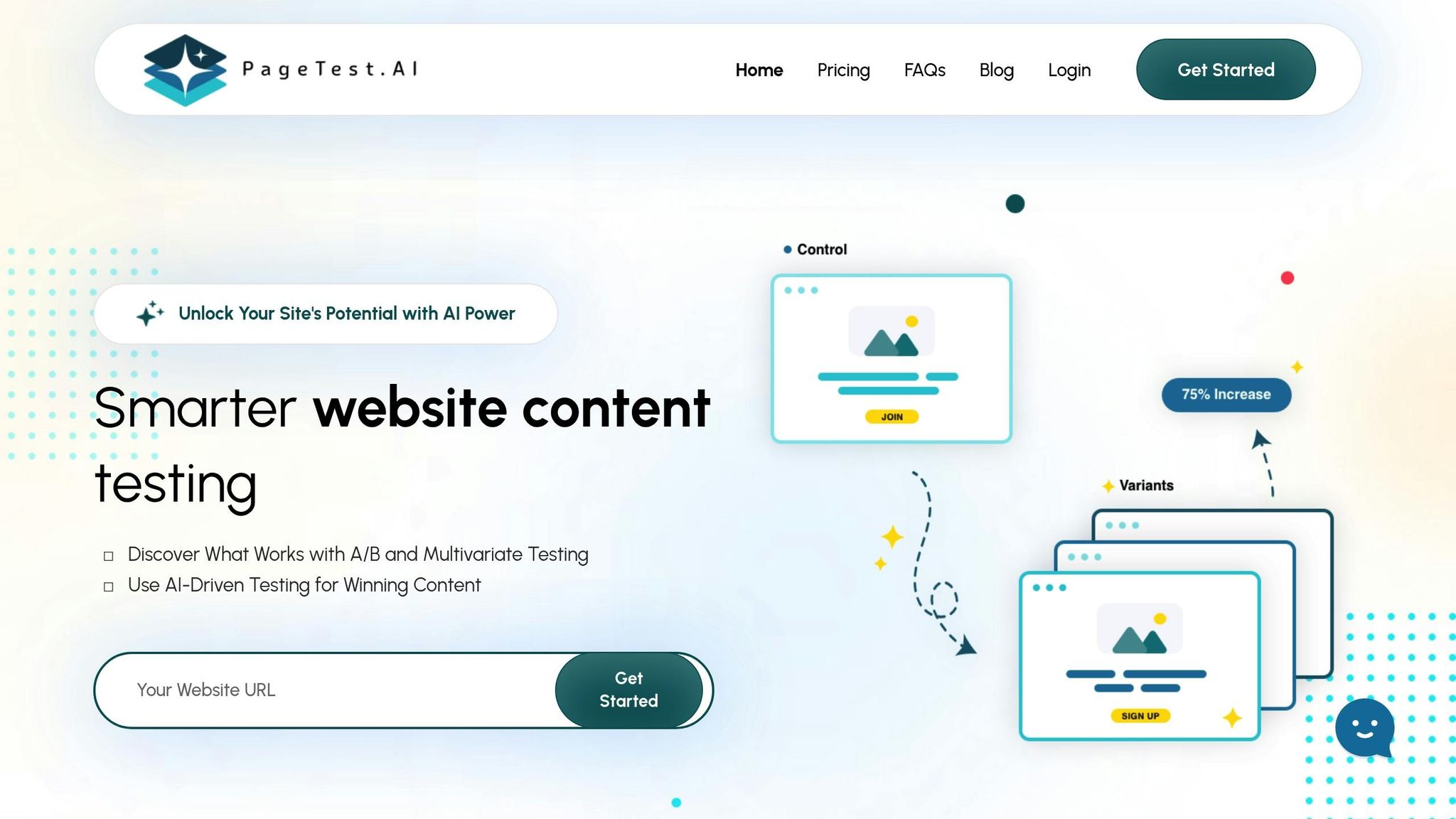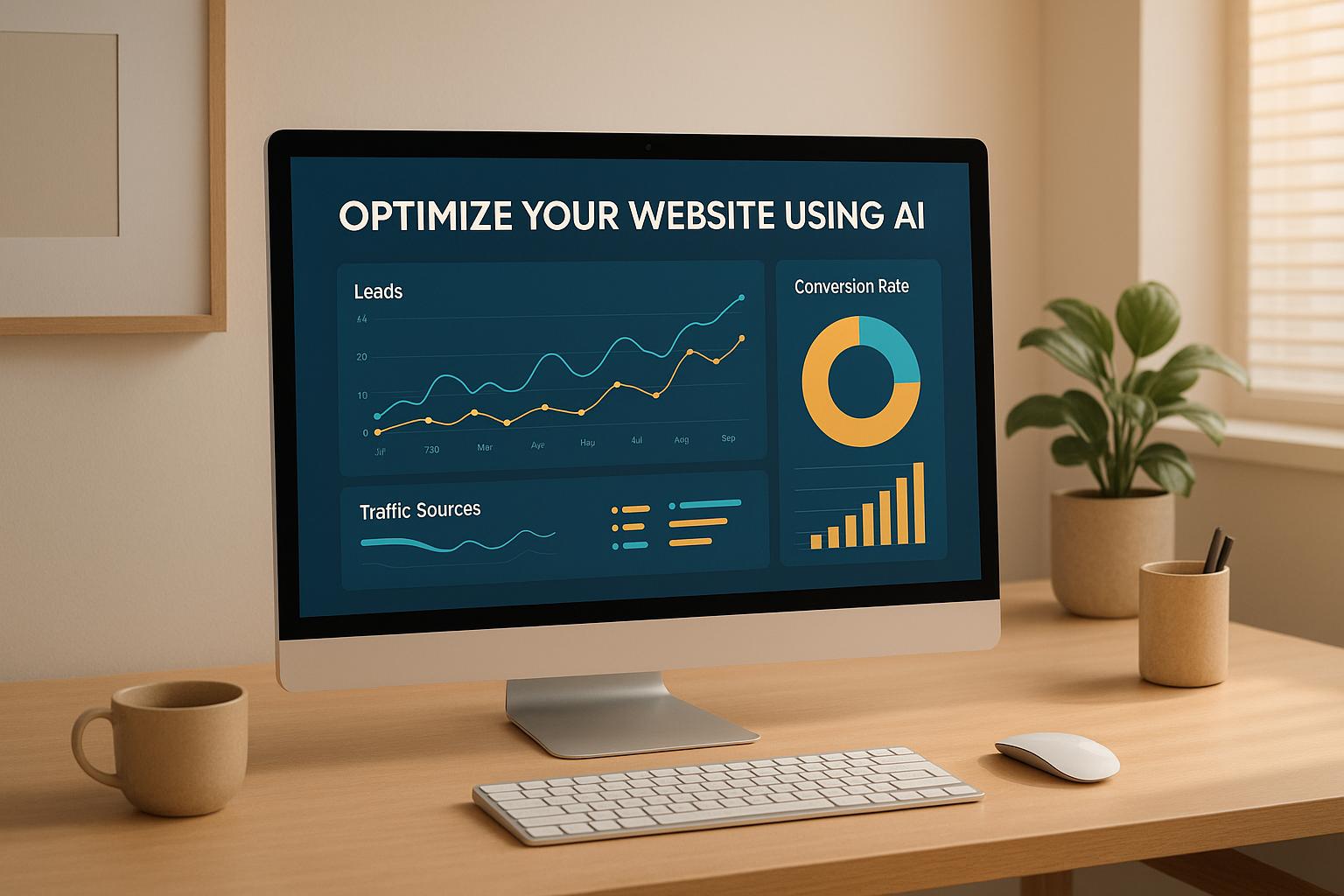

How AI Improves Conversion Testing for High-Traffic Sites

How AI Improves Conversion Testing for High-Traffic Sites
 23-08-2025 (Last modified: 03-09-2025)
23-08-2025 (Last modified: 03-09-2025)
For high-traffic websites, even a small boost in conversion rates can mean thousands of new customers and a big revenue increase. But traditional conversion rate optimization (CRO) methods are slow, complex, and resource-heavy. Enter AI-powered tools like PageTest.AI, which simplify and speed up the process by automating test creation, deployment, and analysis.
Key Takeaways:
- AI platforms save time by testing multiple variations (e.g., headlines, CTAs) at once.
- Personalization is easier with real-time user behavior analysis, tailoring content for different audiences.
- Data insights are automatic, offering clear dashboards to track performance metrics like clicks and engagement.
- Scalability is built-in, handling millions of visitors without slowing down.
Manual testing, while offering more control, is slower, harder to scale, and less effective for high-traffic sites. AI solutions like PageTest.AI offer pricing starting at $10/month, making them accessible for businesses of various sizes. The result? Faster optimizations and increased revenue potential.
Using Generative AI in Conversion Rate Optimization | Shawn David LLM Training V.O.D.
1. PageTest.AI

PageTest.AI is a no-code platform designed to simplify conversion testing for high-traffic websites. It removes the usual hurdles of conversion rate optimization (CRO), allowing marketers and product teams to run advanced experiments without the need for coding or developer assistance.
Here’s how PageTest.AI enhances testing efficiency and personalization for busy sites:
Testing Speed
When it comes to high-traffic websites, speed can make or break conversion opportunities. PageTest.AI leverages AI-powered automation to significantly cut down testing time. Instead of relying on slow, manual processes, the platform quickly generates, deploys, and tests multiple variations – like headlines, calls-to-action (CTAs), button text, and product descriptions – across different user groups simultaneously. This faster approach is a game-changer for high-traffic sites, where acting quickly is essential. Users have reported an average 15% increase in conversions compared to traditional testing methods.
Personalization Capabilities
PageTest.AI takes personalization to the next level by analyzing user behavior, demographics, and engagement in real time. The platform can dynamically adjust website elements, such as showing one headline to first-time visitors and a different one to returning users. It can also fine-tune product recommendations based on how users interact with the site. For e-commerce businesses, this means they can experiment with tailored strategies for different customer segments, leading to better engagement and higher conversion rates.
Data Analysis & Insights
The platform tracks key metrics such as clicks, engagement, time spent on pages, and scroll depth. All of this data is presented on easy-to-read dashboards, making it simple to identify what’s working. With AI-driven insights, marketers can quickly pinpoint which content variations resonate with specific audiences and even uncover trends based on the time of day. These actionable insights make it easier to optimize content effectively. For high-traffic sites, even small adjustments can translate into substantial revenue growth.
Scalability
Built to handle enterprise-level demands, PageTest.AI’s cloud infrastructure ensures smooth performance even during traffic surges. It can test and optimize content for millions of users at once without slowing down site performance. Plus, it integrates seamlessly with popular platforms like WordPress, Wix, and Shopify, making it easy to deliver personalized experiences to every user segment while maintaining reliable performance.
2. Manual Testing Methods
Manual testing, widely used on high-traffic websites, often struggles to keep up with the increasing complexity and volume of modern digital environments. These challenges have prompted many organizations to explore automated and AI-driven testing solutions as an alternative.
Testing Speed
One of the biggest drawbacks of manual testing is the time it takes. Each test case can take several minutes to execute, which becomes impractical when testing numerous variations simultaneously. For instance, if you’re testing five different headlines against three unique CTAs, you end up with 15 combinations. Each of these combinations requires its own setup, execution, and analysis. This time-intensive process can significantly delay testing cycles, often causing businesses to miss key optimization opportunities during high-traffic periods.
Data Analysis & Insights
Another challenge lies in analyzing the data. With manual testing, teams have to gather metrics from various sources, compile reports, and interpret the results – all before making decisions on optimizations. This lengthy process not only delays insights but also limits the depth of analysis. For example, tracking detailed user behaviors like scroll depth or time spent on specific sections of a page can be difficult to capture and analyze quickly. These delays can hinder the ability to act on valuable trends in real time.
Scalability
Scaling manual testing is another major hurdle, especially for enterprise-level operations involving large volumes of test variations. As the number of tests increases, so does the human effort required to manage them. This makes it nearly impossible to keep up with the demands of high-traffic sites, particularly when testing needs to account for multiple devices, browsers, and user segments simultaneously.
| Aspect | Manual Testing Limitations |
|---|---|
| Speed | Takes minutes per test case; processes tests sequentially |
| Coverage | Limited by available time and resources |
| Scalability | Requires linear effort increase for additional tests |
These limitations are especially problematic during critical periods like holiday shopping seasons or major product launches, when quick testing and timely optimizations are essential. While manual testing can provide basic insights, its inherent constraints make it clear why more dynamic, automated approaches are becoming essential for modern testing needs.
sbb-itb-6e49fcd
Pros and Cons
This section takes a closer look at how AI-powered testing stacks up against manual methods, focusing on key factors like speed, data analysis, scalability, cost, and setup complexity.
When it comes to AI-powered platforms like PageTest.AI, they shine in areas where manual testing often struggles. Thanks to automation, these platforms can test multiple variations simultaneously, sidestepping the delays caused by testing one at a time. They also provide advanced data analysis by automatically tracking metrics and user behaviors, delivering real-time insights without the hassle of manual data compilation.
That said, AI-powered tools come with a few challenges. For one, transitioning from manual methods to AI platforms involves a learning curve. There’s also the matter of cost – PageTest.AI, for instance, starts at $10 per month for 10,000 test impressions, while enterprise plans can range from $50 to $200 per month, depending on the volume of testing required. On the other hand, manual testing offers full control over every aspect without recurring subscription fees, which can be appealing for smaller operations.
Manual testing, while offering complete control, demands significant time and effort. For businesses with limited testing needs, it can be a cost-effective option. However, its limitations become evident as testing demands grow. Each additional test adds to the workload, making it hard to keep up during high-traffic periods when quick optimizations are vital.
| Aspect | AI-Powered Testing (PageTest.AI) | Manual Testing |
|---|---|---|
| Speed | Tests multiple variations at once | Sequential testing; slower process |
| Scalability | Handles large volumes with ease | Effort increases with scale |
| Data Analysis | Provides real-time automated insights | Requires manual data collection |
| Cost Structure | Monthly plans ($10–$200) | No fees, but time-intensive |
| Setup Complexity | No-code, user-friendly | May require technical skills |
The right choice depends on the scale of testing and business priorities. High-traffic websites with thousands of daily visitors often benefit from the speed and scalability of AI-powered tools. Meanwhile, smaller operations with occasional testing needs may find manual approaches more practical.
For businesses that experience seasonal traffic spikes or run frequent campaigns, the ability to quickly test and analyze multiple variations can make AI-powered platforms worth the investment. Faster insights lead to quicker optimizations, which can translate into increased revenue during critical periods.
Conclusion
AI has revolutionized conversion testing, turning what was once a slow, manual process into a fast, data-driven operation. For businesses managing thousands of visitors daily, the ability to test multiple variations simultaneously and gather real-time insights is no longer a luxury – it’s a necessity to remain competitive.
Relying on week-long testing cycles can mean missing out on critical revenue opportunities, especially during seasonal peaks, product launches, or ongoing optimization efforts. AI-powered platforms solve these challenges by automating tasks like content generation and user behavior analysis, making the entire process more efficient.
The choice between manual testing and AI-driven solutions often depends on your website’s traffic and testing needs. Sites with lower traffic and occasional testing might manage with traditional methods. But for high-traffic operations, tools like PageTest.AI offer clear advantages. With scalable pricing starting at $10 per month for 10,000 impressions and going up to $200 for 1 million impressions, PageTest.AI ensures businesses only pay for what they need. Its no-code design also empowers marketing teams to run experiments independently, speeding up optimization and eliminating unnecessary delays.
The ability to identify winning variations in just days – not weeks – can have a direct and significant impact on revenue. For high-traffic websites, even small improvements can add up to substantial gains over time.
As businesses adapt to user preferences more quickly, they position themselves to thrive in today’s competitive digital landscape. AI-powered conversion testing delivers the speed, scale, and insights needed to drive growth and stay ahead in the ever-evolving online marketplace.
FAQs
How is AI-powered conversion testing different from traditional manual testing?
AI-driven conversion testing takes optimization to the next level by leveraging machine learning to understand user behavior, generate test variations, and adapt on the fly. This approach speeds up the process and works particularly well for websites with heavy traffic.
What sets AI testing apart from traditional manual methods is its ability to adjust dynamically. Manual testing relies on fixed scenarios and constant human involvement, while AI testing evolves with changes in website content and user interactions. It offers wider test coverage and delivers useful insights faster, making it a powerful tool for businesses looking to boost their conversion rates efficiently.
How does PageTest.AI help high-traffic websites improve personalization and analyze data effectively?
PageTest.AI takes the guesswork out of conversion optimization for high-traffic websites by leveraging AI to craft tailored content variations. These include headlines, CTAs, and product descriptions, which are then tested using A/B or multivariate experiments to uncover what connects best with your audience.
Beyond just creating variations, the platform delivers in-depth performance analytics. It tracks crucial metrics like clicks, engagement, and user behavior, giving businesses the insights they need to refine user experiences and boost conversions effectively.
Is using AI-powered tools like PageTest.AI a smart investment for small and medium-sized businesses?
Yes, AI-driven platforms such as PageTest.AI offer an affordable way for small and medium-sized businesses to improve their website performance. These tools simplify the process of conversion testing by automating tasks that would otherwise require significant time and effort. Plus, they provide flexible options that can work with a range of budgets.
With AI, businesses can easily test and refine key website elements – like headlines, call-to-action buttons, and product descriptions – to enhance conversion rates. This means you can achieve better results without having to stretch your marketing budget, making tools like PageTest.AI a smart investment for driving growth.
Related posts
say hello to easy Content Testing
try PageTest.AI tool for free
Start making the most of your websites traffic and optimize your content and CTAs.
Related Posts

 01-12-2025
01-12-2025
 Ian Naylor
Ian Naylor
How to Optimize Your Website for More Leads Using AI
Learn how to optimize your website for more leads using AI. Discover actionable tips for better conversions and trust-building strategies.

 01-12-2025
01-12-2025
 Ian Naylor
Ian Naylor
How to Optimize Your Content for SGE and GEO
Discover strategies to optimize your content for traditional SEO, Google’s SGE, and GEO to stay ahead in AI-driven search engines.

 01-12-2025
01-12-2025
 Ian Naylor
Ian Naylor
Complete Guide to On-Page Technical SEO for Local Sites
Discover key technical SEO strategies to boost local search rankings, covering crawlability, indexation, site structure, and more.
